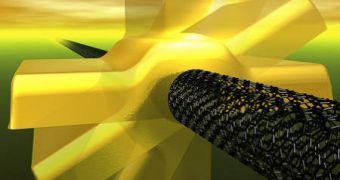A team of chemistry experts at the University of Florida have finally managed to put together a device that is able to convert sunlight directly into motion, though admittedly only at the nanoscale. The new “molecular nanomotor” is entirely photon-driven, and operates solely on the basis of the particles that create light. It's a well-known fact that photons disappear if they stop, but that they have a lot of energy, which can be harnessed. Details of the find are scheduled for publication in an upcoming issue of the prestigious journal Nano Letters.
The research team says that the new motor is constructed entirely out of a single DNA molecule, which gives it an increased simplicity, as opposed to other types of similar structures, which are made from several pieces. It only measures between 2 and 5 nanometers, and could have a large array of applications in research fields such as medicine and product manufacturing. “It is easy to assemble, has fewer parts and theoretically should be more efficient,” says the first author of the paper, UF chemistry doctoral student Huaizhi Kang.
The device, which is extremely small, exists in two different states, clasped or unclasped. In the former, it only extends as much as 5 nanometers from one end to the other, while, in the latter, it stands between 10 and 12 nanometers long. Despite the fact that it's only able to exert a force proportional to its size, the innovation can draw up more photon energy than the most advanced solar cells in existence today.
“Preparation of DNA molecules is relatively easy and reproducible, and the material is very safe,” adds UF chemistry doctoral student Yan Chen, who is also one of the paper authors. “The major difficulty lies ahead. That is how to collect the molecular level force into a coherent accumulated force that can do real work when the motor absorbs sunlight. Some prototype DNA nanostructures incorporating single photo-switchable motors are in the making which will synchronize molecular motions to accumulate forces,” explains the leader of the research group, UF professor of chemistry and physiology Weihong Tan.

 14 DAY TRIAL //
14 DAY TRIAL //